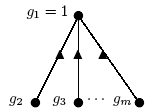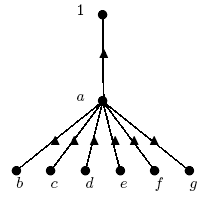
|
|||||||||||||||
|
|||||||||||||||
The \(n^{th}\)-roots of elements of a finite group and their associated digraphK. Ahmadidelir Abstract. In this talk, first we introduce a digraph assigned to the \(n^{th}\)-roots of elements of a finite group \(G\) and investigate algebraic properties of this group using the graph theoretical concepts. Then we try to ask and answer some questions about the recognisability and characterising a finite group by its all associated \(n^{th}\)-roots digraphs. 1. Introduction An element \(g\) of a finite group \(G\) is said to have an \(n^{th}\)-root if there exists an element \(h\in G\) such that \(g=h^n\) (\(n\) is a positive integer). Note that \(g\) may have at least an \(n^{th}\)-root, or it may have none.Let \(G^n\) be the set of all elements of \(G\) which have at least one \(n^{th}\)-root, i.e.: \[G^n=\{g\in G\mid \exists\; h\in G \;s.t.\; g=h^n\}\]
or, simply, \(G^n=\{g^n\mid g\in G\}\). Then
\(P_n(G)=\frac{|G^n|}{|G|}\) is the probability that a randomly
chosen element in \(G\) has an \(n^{th}\)-root.
The properties of \(P_2(S_n)\), where \(S_n\) denotes the symmetric group on \(n\) letters have been studied by some authors in [2,5]. Recently, the basic properties of \(P_2(G)\) for an arbitrary finite group \(G\) have been studied (for example, see [3,4]). Already, some years ago in [1], we generalized the probability to \(p^{th}\)-root (\(p > 2\) is a prime number) and gave some bounds for it. We showed that the set \(X=\{P_p(G)\mid G\) is a finite group\(\}\) is a dense subset of the closed interval \([0,1]\). Now, in some way, we want to use \(n^{th}\)-roots to characterise finite groups. First of all, we introduce a new digraph assigned to the \(n^{th}\)-roots of the elements of a finite group \(G\), as follows: Definition 1. The digraph associated to the \(n^{th}\)-roots of the elements of a finite group \(G\) is a directed graph whose vertices are whole elements of \(G\) so that any two distinct vertices \(x\) and \(y\) are joined by an edge directed from \(x\) to \(y\) if and only if \(x^n=y\). We denote this digraph by \(\Gamma_n(G)\), or simply by \(\Gamma_n\). Remark 1. Let \(G\) be a finite group. Some of elementary properties of the digraph \(\Gamma_n(G)\) defined above are:
2. Some properties of \(n^{th}\)-roots in finite groups In this section, we give some elementary results about \(G^n\), where \(G\) is a finite group.Proposition 2.1 Let \(G\) be a finite group with order \(m\). Let \(n\) be a positive integer. Then \(G^n=G^r\), where \(r\) is the remainder of division of \(n\) by \(m\) (\(n=mq+r;\;\;0\leqslant r < m\)). Remark 2. By the above proposition, in computing the \(n^{th}\)-roots of a finite group \(G\) of order \(m\) (respectively, computing \(P_n(G)\)), it suffices to compute the \(r^{th}\)-roots only for \(0\leqslant r< m\). The next propositions reduces the computations of \(G^n\) to \(G^r\), where \(0\leq r<\exp(G)\), the exponent of \(G\). Proposition 2.2 Let \(G\) be a finite group with exponent \(\exp(G)=e\). Let \(n\) be a positive integer. Then \(G^n=G^r\), where \(r\) is the remainder of division of \(n\) by \(e\) (\(n=eq+r;\;\;0\leq r < e\)). Proposition 2.3 Let \(G\) be a finite group with exponent \(\exp(G)=e\). Let \(n\) be a positive integer. Then \(G^k=G^{e-k}\) for every integer \(k\), where \(1\leq k\leq e\). Remark 3. By the above propositions, in computing the \(n^{th}\)-roots of a finite group \(G\) of order \(m\) and exponent \(e\) (and so, computing \(P_n(G)\) and drawing \(\Gamma_n(G)\)), it suffices to compute the \(n^{th}\)-roots only for \(0\leq r< \lfloor \frac{e+1}{2}\rfloor\) (instead of \(0\leq r< e\)). So, \[\forall k=1,\ldots,e-1, \quad P_k(G)=P_{e-k}(G)\] and \(P_e(G)=\frac{1}{|G|}\). On the other hand, for every \(x,y\in G\), \(x^k=y\) if and only if \(x^{e-k}=y^{-1}\), namely, \(x\) is a \(k^{th}\)-root of \(y\) iff \(x\) is a \((e-k)^{th}\)-root of \(y^{-1}\). Therefore, in spite of \(P_k(G)=P_{e-k}(G)\), but the digraphs of \(k^{th}\)-roots and \((e-k)^{th}\)-roots of \(G\) are not the same. Indeed, if the graph of \(k^{th}\)-roots be connected, then to get the digraph of \((e-k)^{th}\)-roots from that, it is sufficient to replace the roots with their inverses from bottom to top of that graph. 3. Some results about the digraph associated to \(n^{th}\)-roots Let \(p\in \pi(G)\) denote the set of all prime divisors of a finite group \(G\). Then we have:Theorem 3.1 For a finite group \(G\), \(\Gamma_n(G)\) is in-tree (a digraph that its underlying graph is a tree and have a unique sink), and have \(1\) as its sink, if and only if for all \(p\in \pi(G)\), \(p|n\). Corollary 3.2 Let \(G\) be a finite group of order \(m\) and \(e=exp(G)\). Then \(\Gamma_n(G)\) is as follows:  In particular, an abelian group \(G\) is an elementary abelian \(p\)-group of order \(m\) if and only if \(\Gamma_p(G)\) is as above. 4. Recognition of a finite group by its associated digraphs \(\Gamma_n\) In recent years, there have appeared many "recognition problems", such as:
There are many published papers about the characterization of finite groups (especially, simple ones) by these recognition problems. So, we have a good motivation to introduce another one. In this section, we want to discuss the recognition of a finite group by its associated digraphs of \(n^{th}\)-roots of elements. Now, the question is: Can we characterize the finite group \(G\) with some of \(\Gamma_n(G)\), where \(1\leq n\leq exp(G)\), up to isomorphism? In other words, are these diagrams another recognition test for a finite group \(G\)? By the results of previous sections, we have the following theorem: Theorem 4.1 Two finite abelian groups \(G\) and \(H\) with same exponent \(e\) are isomorphic if and only if, for all \(n\), \(1\leq n\leq e\), \(\Gamma_n(G)\cong\Gamma_n(H)\). But some of the \(\Gamma_n\)'s (for some \(n\)'s) are redundant. For example, \(\Gamma_1\) and \(\Gamma_e\) (\(e\) is the exponent of these groups) are trivial ones (they are the same in all of the groups with the same exponent). So, the next question is: What is the least number of these diagrams to recognize a given group with them and which ones are necessary (irredundant)? For example, we can recognize the quaternion group \(Q_8\) by a \(\Gamma_n\) diagram (for some \(n\)) as follows (it is the unique group up to isomorphism with this diagram):  But we can recognize the dihedral group \(D_8\) by a diagram \(\Gamma_n\) (for some \(n\)) as follows:  On the other hand:
Also, both of the elementary abelian groups of order 27, and the non-abelian group of order 27 with exponent 3 have similar diagrams (\(\Gamma_n\)'s for \(n=1,2,3\)). So, the above theorem is not true for two arbitrary groups. Of course, it is trivial that, for any isomorphic two groups \(G\) and \(H\) we have \(\Gamma_n(G)\cong\Gamma_n(H)\), for all \(n\). Finally, with the above remarks in mind, we can ask the following questions: Question 1. Can we extend theorem 4.1 to some other classes of groups? Question 2. For a finite group \(G\), what is the minimum number of digraphs of \(n^{th}\)-roots, where \(1\leq n\leq exp(G)\), to characterise it? References
|
|||||||||||||||
|
© 2013 SIM SB RAS
|
